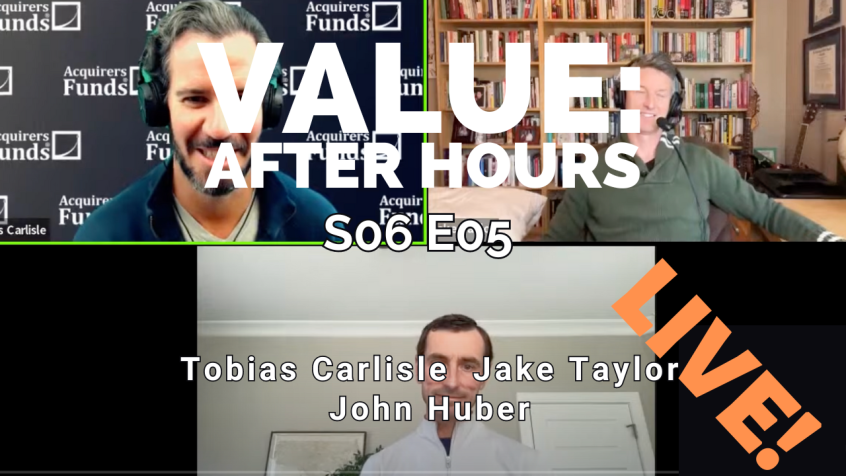During their latest episode of the VALUE: After Hours Podcast, Taylor, Carlisle, and Huber discussed Buffett’s Korean Basket Bet: Achieving Diversification and High Returns. Here’s an excerpt from the episode:
Tobias: There’s good comment here from Dimitrios. “This is why starter investors tend not to appreciate diversification and are under-diversified.” How do you feel about diversification, John? How do you approach that problem?
John: Yeah, it’s really interesting because that– Ideally, you want to have more diversification is better, because you’re going to achieve that same result that we’re talking about here in mathematical terms, like, if you had 30 stocks that all have the same risk-reward profile, it’s like running an insurance operation. The more lives you can insure, the better. And so, more diversification is better. I think the reality though, you got to play within the confines of reality.
And for me, the reality is there’s just not that many ideas. I’m not saying 30 is right or wrong, just generally speaking, my appetite for diversification is not satiated by the reality of just not that many ideas. And so, I have fewer ideas. But I do think you need to allow yourself room for error. So, whatever level is right for you, I think investors have to figure that out. That’s more of a personal decision, what do you feel comfortable with? What are you good at? You want to be able to stick with positions over the long run. So, I do think you need some level of diversification that is a baseline minimum. And then above that, it’s more a matter of your strategy and your personality and your risk appetite and that type of thing. But generally speaking, diversification is a good thing.
Tobias: What’s a baseline minimum for you?
John: In Ecclesiastes, Solomon said that “You should invest in seven or eight ventures because you don’t know what kind of disaster is going to come across the land.” Solomon, he was one of the richest men ever, seven or eight is what he recommended. That’s probably saying that tongue in cheek. Charlie Munger says, “Hey, three is all you need.” That’s too little for me. [Jake [laughs] That’s not enough. And honestly, if you look at his own portfolio, he had Berkshire, and he talked about Berkshire and Costco and Li Lu’s fund. But those are investments in and of themselves that are very diversified. So, I think that’s different. I think you need to look at what types of companies you own.
If you own six or seven holding companies, then you’re probably going to be very diversified. If you own a company that has 40% of its revenues coming from one customer, that’s not enough. You’re going to need more of those. So, seven or eight would not be enough. Yeah, generally speaking, I think 10 is like a minimum. I’m not suggesting that’s the right number, and I’m not suggesting there is a right number. I’m just saying, for me, 7, 8, 10 is a baseline minimum. And then I’m also okay having a group of investments that cover a basket in certain cases. I’m thinking along those lines with a couple of different investments right now where you might be diversified within the basket.
Buffett talked about concentration. Number one, he does have a lot of stocks. And number two, he would invest in baskets in his personal portfolio. Like, in Korea 20 years ago, he made a basket bet in Korea, and he just bought a bunch of them because you could achieve those numbers. You could get diversification and still get the return profile that you were looking for. And that’s the ideal situation.
Jake: Japan [crosstalk]
John: Yeah, Japan.
Tobias: Conglomerates. Yeah.
Jake: Even before that though, in his PA.
John: Yeah. I think it was Korea, if I’m not mistaken. He invested in a bunch of– He talked about this cement manufacturer that was trading three times earnings and stuff, and he found a bunch of those. Maybe it was Japan as well. That would be ideal. I was rereading his partnership letters recently. I was reading through those because that was a moment in time where he was running money more similar to, I think, all of us pretty much. We’re maybe running money professionally. Or, even if you’re an individual, those letters are much more applicable in terms of portfolio management I think, then you’re going to learn a lot more about business by reading, obviously, the more current letters. But he’s got some interesting nuggets on portfolio management where he buckets these investments into three or four different categories, and he’s got generals and workouts and how those play off against each.
He was fairly concentrated. He had like five or six or seven that represented half of his money. He obviously had big position in American Express, big position in Disney at times, but he also had, at the other end of the portfolio, had a bunch of different small workouts. It’s not like an either or. You could have kind of both depending on the opportunity set.
You can find out more about the VALUE: After Hours Podcast here – VALUE: After Hours Podcast. You can also listen to the podcast on your favorite podcast platforms here:
For all the latest news and podcasts, join our free newsletter here.
Don’t forget to check out our FREE Large Cap 1000 – Stock Screener, here at The Acquirer’s Multiple:



